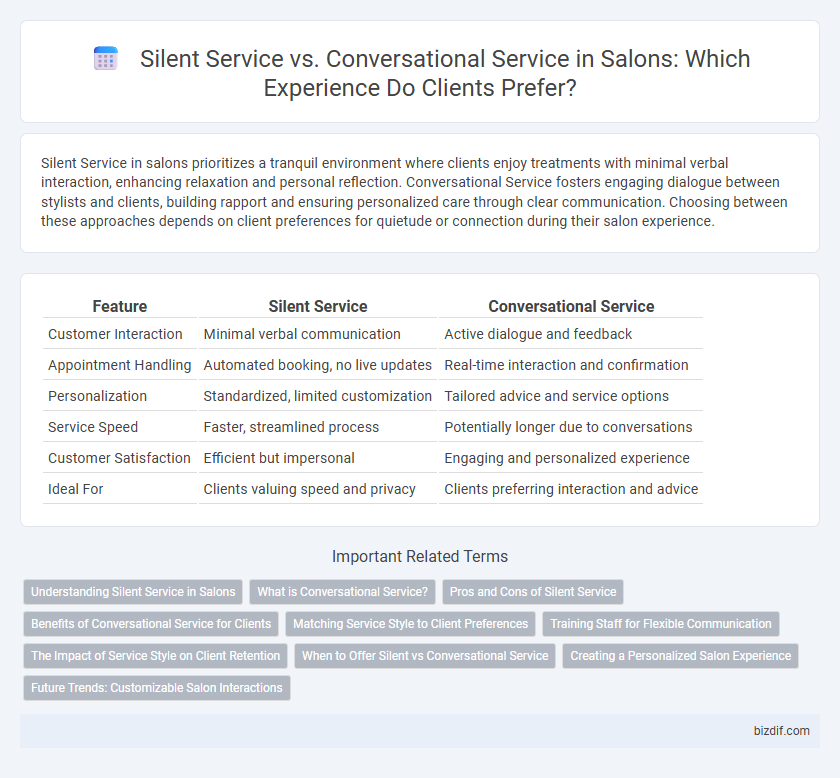Silent Service in salons prioritizes a tranquil environment where clients enjoy treatments with minimal verbal interaction, enhancing relaxation and personal reflection. Conversational Service fosters engaging dialogue between stylists and clients, building rapport and ensuring personalized care through clear communication. Choosing between these approaches depends on client preferences for quietude or connection during their salon experience.
Table of Comparison
| Feature | Silent Service | Conversational Service |
|---|---|---|
| Customer Interaction | Minimal verbal communication | Active dialogue and feedback |
| Appointment Handling | Automated booking, no live updates | Real-time interaction and confirmation |
| Personalization | Standardized, limited customization | Tailored advice and service options |
| Service Speed | Faster, streamlined process | Potentially longer due to conversations |
| Customer Satisfaction | Efficient but impersonal | Engaging and personalized experience |
| Ideal For | Clients valuing speed and privacy | Clients preferring interaction and advice |
Understanding Silent Service in Salons
Silent Service in salons emphasizes non-verbal communication techniques, allowing stylists to intuitively understand client needs through body language, facial expressions, and subtle cues. This approach fosters a calming, personalized experience by minimizing unnecessary dialogue, helping clients feel relaxed and valued. Mastery of silent service enhances client satisfaction and sets salons apart in delivering attentive, discreet care.
What is Conversational Service?
Conversational Service in a salon refers to an interactive, client-focused approach where hairstylists engage in meaningful dialogue to understand individual preferences, lifestyle, and hair care goals. This method goes beyond procedural tasks, fostering a personalized experience that enhances satisfaction and trust. By integrating active listening and tailored recommendations, Conversational Service elevates client relationships and boosts retention rates.
Pros and Cons of Silent Service
Silent Service in salons emphasizes minimal verbal interaction, allowing clients to enjoy a serene and undisturbed experience. Pros include increased relaxation, a calm atmosphere, and fewer distractions, which can enhance customer satisfaction for those seeking tranquility. Cons involve potential miscommunication about service preferences and reduced opportunity for personalized recommendations compared to Conversational Service.
Benefits of Conversational Service for Clients
Conversational service in salons enhances client satisfaction by providing personalized interactions tailored to individual preferences and needs. This approach fosters a more engaging and relaxing environment, encouraging clients to share feedback and request specific styles or treatments. Clients benefit from increased trust and better service outcomes resulting from open communication with their stylist.
Matching Service Style to Client Preferences
Matching service style to client preferences involves understanding the difference between Silent Service and Conversational Service in salons. Silent Service caters to clients seeking a calm, quiet experience with minimal interaction, while Conversational Service suits those who prefer engaging dialogue and personalized communication during their appointment. Tailoring the approach enhances client satisfaction, promotes loyalty, and ensures a comfortable salon environment.
Training Staff for Flexible Communication
Training salon staff in silent service emphasizes non-verbal cues, body language, and attentive observation to enhance client comfort and satisfaction without constant dialogue. Conversational service training develops employees' skills in engaging clients through personalized dialogue, active listening, and responsive communication to build rapport and trust. Flexible communication training equips staff to seamlessly switch between silent and conversational modes, optimizing client experience based on individual preferences and salon ambiance.
The Impact of Service Style on Client Retention
Silent Service in salons emphasizes minimal verbal interaction, creating a calm and relaxing environment that appeals to clients seeking tranquility, which can enhance client retention through stress reduction. Conversational Service fosters active engagement and personalized communication, building strong client-stylist relationships that increase loyalty and repeat visits. Understanding the impact of these service styles helps salons tailor experiences to client preferences, directly influencing satisfaction and long-term retention rates.
When to Offer Silent vs Conversational Service
Silent service suits clients seeking relaxation and privacy, such as during deep conditioning or scalp treatments, enabling a tranquil atmosphere. Conversational service fits appointments like haircuts or consultations where client stylists need interaction to ensure preferences and style outcomes are accurately understood. Choosing between silent and conversational service depends on client mood, treatment type, and desired experience to maximize comfort and satisfaction.
Creating a Personalized Salon Experience
Silent Service in salons emphasizes discreet, non-intrusive interactions, allowing clients to relax while stylists focus on precision and personalized care. Conversational Service fosters engagement through friendly dialogue, helping stylists understand client preferences deeply and offer customized recommendations. Combining both approaches enhances client satisfaction by tailoring the salon experience to individual comfort and communication styles.
Future Trends: Customizable Salon Interactions
Silent service and conversational service represent two distinct approaches to client interactions in salons, with future trends emphasizing customizable salon experiences. Advanced AI and data analytics enable salons to tailor interactions based on individual preferences, blending silent service for clients valuing privacy and conversational service for those seeking engagement. This customization enhances customer satisfaction, driving loyalty and setting a new standard in personalized beauty care.
Silent Service vs Conversational Service Infographic

 bizdif.com
bizdif.com